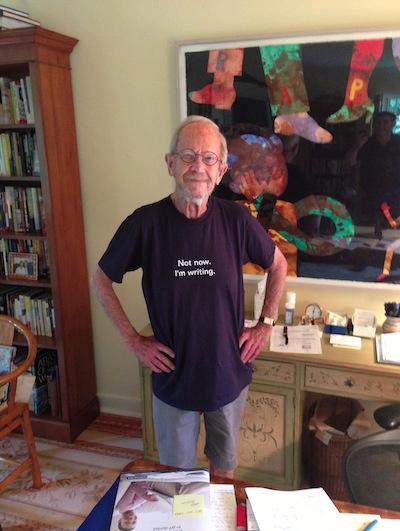Elmore Leonard: That Guy Was a Helluva Writer
By • August 29, 2013 0 1929

Elmore Leonard, the writer, died Aug. 20 of complications from a stroke, according to his researcher. He was 87. He had three wives, five children, 13 grandchildren and five great-grandchildren and also sired dozens of books, numerous short stories and numerous movies, made-for-TV movies and television episodes, based on the numerous short stories and novels that he wrote with a clean clarity that rivaled Ernest Hemingway, whose style inspired him, Leonard said, except that “he didn’t have a sense of humor.”
A lot already has been made over Leonard’s writing: that it was artful, stylish and included the best dialogue ever written, that his books looked you straight in the eye and were examples of American prose and American talk. Claims will be made for his work’s higher meaning, all of which Leonard, plain spoken, funny and tough, would probably smile about. But then again, lots of people think “Moby Dick” was about a white whale being chased by Gregory Peck.
I think it’s fair to say, nevertheless, that Leonard was a pro, a guy with a degree in English and philosophy, who wrote in the American vernacular. He probably had a philosophy — plus ten rules about writing — which centered around the sin of over-writing and taking oneself too seriously. This turns out to mean that he was a very serious man, who didn’t break his own rules too much. “If it sounds like writing, I rewrite it,” he said. That was rule numero uno.
Leonard started out writing westerns and short stories, working in the age of pulp fiction at the start, although his work always seemed a cut above such a useless category—because you could find people like Max Brand, Dashiel Hammett, Ross McDonald and Raymond Chandler in there. He was a working stiff, supporting a wife and five children, and he did mighty, fine work even back then, some of which would also become movies—the first version of “3:10 to Yuma,” starring Glenn Ford and Van Heflin, and the more recent version starring Russell Crowe. But he also sold a story that would become a movie called “Hombre,” starring Paul Newman as a half-breed gunslinger which got him enough cash to breathe a little easy, or long enough to enter the arena of what he liked to think of as regular novels.
Truth to tell, Leonard’s writings were thrillers or novels which centered around criminals and crimes of one sort or another, with complicated anti-heros, smart, tough and sexy women and villains that were psychopaths, killers, corrupt cops and politicians, scam artists, grifters, mobsters and hit men, a revolutionary or two, political hacks and the like. Many of them, even the most evil of men, waxed wise, when threatening folks or being threatened, or avoided commitment to jail or love. Some of his protagonists were better than they should be. Others fell way short, although not a guy named Shorty from a book called “Get Shorty.” And they talked—they talked more than three Irishmen at the same table in a bar or your mother-in-law.
Over time, I will admit to reading most of his books, because while you could be sure of the authenticity of the stuff in it, you never knew where it would go, where it was set, or how exactly it was going to end—partly because the good guys were so intimately connected to the bad guys and partly because there were smart female characters in them, who revealed very little except when they would end up in the bed of the leading male character. Even then, they gave up not so much.
The following are a few of my favorites in no special order.
= “52 Pick-Up”: a really nasty book in which a powerful guy gets blackmailed over adultery by psychotic types (Roy Scheider and Ann-Margret in the movie).
= “Get Shorty”: the best book about Hollywood and its scumbags ever written—take that F. Scott– funny, cheerfully mean-spirited, scathing and sharp with John Travolta as a made guy and fixer type, who looks like a crusader compared to the Hollywood types in the movie version, which featured Gene Hackman.
= “Cat Chaser”: drug dealers and other bad guys and women in Miami.
= “Out of Sight”: a bank robber who takes too much care with his give-me-the-money notes (George Clooney and Jennifer Lopez in the movie).
= “Cuba Libre”: set in the time of the Spanish American war.
= “Maximum Bob,” “Tishimingo Blues” and “La Brava”.
Oh, the hell with it. I loved everyone of the books I read, and I am about to start another for the sheer celebration of it. Why? I love the title: “Up In Honey’s Room.”
It starts this way: “Honey phoned her sister-in-law Muriel still living in Harlan County, Kentucky, to tell her she’d left Walter Schoen, calling him Valter, and was on her way to being Honey Deal again. She said to Muriel, “I honestly thought I could turn him around but the man still acts like a Nazi. I couldn’t budge him.” The last line of the book is: “ You gonna tell her about Honey walking around in her high heels, naked?”
My guess he won’t. That’s some woman, that Honey.
That’s some writer, that Elmore Leonard.

